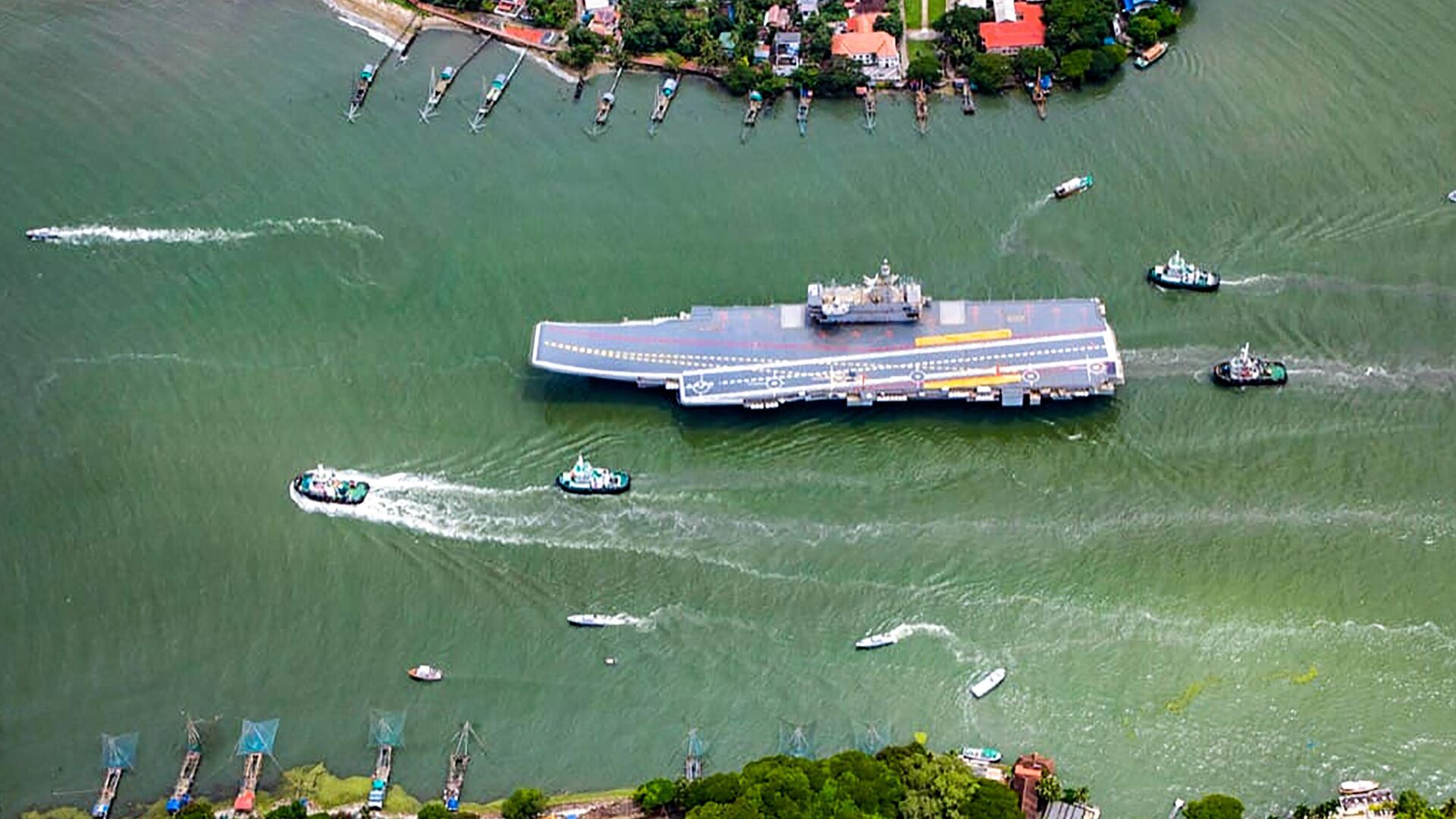https://sputniknews.in/20240808/whats-behind-navys-pursuit-of-more-aircraft-carriers-7985436.html
What's Behind Navy's Pursuit of More Aircraft Carriers
What's Behind Navy's Pursuit of More Aircraft Carriers
Sputnik India
The Indian Navy's need for a 65,000-tonne aircraft carrier remains firm and undiminished but this gigantic vessel can wait for the moment because a third aircraft carrier (smaller size) is an operational requirement given the South Asian nation's increasing role in the vast Indian Ocean Region (IOR), naval experts have said.
2024-08-08T20:55+0530
2024-08-08T20:55+0530
2024-08-08T22:14+0530
sputnik opinion
indian navy
warship
indian ocean
india
delhi
new delhi
arabian sea
bay of bengal
indo-pacific
https://cdn1.img.sputniknews.in/img/07e8/02/0e/6538965_0:152:3099:1895_1920x0_80_0_0_67d30ec3ee2d7c3d22652f39559588ff.jpg
The Indian Navy's need for a 65,000-tonne aircraft carrier remains firm and undiminished but this gigantic vessel can wait for the moment because a third aircraft carrier (smaller size) is an operational requirement given the nation's increasing role in the vast Indian Ocean Region (IOR), naval experts have said.The pressing need for a 65000-tonne aircraft carrier for air power and cover at sea, especially during peacetime, humanitarian assistance, disaster relief, and emergency evacuations remains undiminished, according to Commodore (Retd) Ranjit B Rai, who also served as Director Naval Intelligence and Director Naval Operations.He underlined that this necessity stands firm despite the arguments put forth by critics that these warships are white elephants.Meanwhile, Vice Admiral (Retd) Biswajit Dasgupta, an ex-chief of the world's largest democratic state's Eastern Naval Command, believes that a third aircraft carrier is certainly required.He opined that the logic for this was simple: of the three carriers, one would invariably be under repairs, making the remaining two available for operations, wherein one each would be used at the Eastern and Western seaboard.Finalising the Size of the Third Aircraft Carrier is a Complex AffairHe elaborated that a carrier of that size would perhaps have to be nuclear-powered, and that will require significant investments in material management, repair technology, and human resource training. Besides, such carriers are usually accompanied by a nuclear-powered attack submarine (SSN) as part of the task force.Therefore, the acquisition of a 65,000-tonne-plus aircraft carrier should not be seen just as adding another platform as it will require major changes in material, repair, training and operational philosophies, the former Eastern Naval Commander added.In turn, whilst it may be better to have large aircraft carriers with a displacement of 65,000 tonnes, at present India's capacity and expertise lies in building a repeat order of a carrier of over 40,000 tonnes which can be operated on the Manned UnManned Teaming (MUMT) concept, Vice Admiral (Retd) SN Ghormade, the former Vice-Chief of the Indian Navy, echoed.Ghormade suggested that India's third indigenous aircraft carrier (fourth one) must be planned to be a 65,000-tonne vessel that will have a greater capacity to carry a larger number of aircraft, drones, remotely-piloted Aircraft along with a credible AMD (Anti-Missile Defence) and ASW (Anti-Submarine Warfare) capability.He stressed that it would have better sustenance and have the ability to provide greater sea control and power projection in India's area of interest.Economic Benefits of Constructing an Aircraft CarrierLikewise, Aritra Banerjee, who co-authored the book 'The Indian Navy @75: Reminiscing The Voyage', delving into the economic benefits of building another aircraft carrier for India's blue water force, noted that building a 65,000-tonne aircraft carrier would significantly boost the Indian shipbuilding industry and generate thousands of direct and indirect jobs. He mentioned the construction of INS Vikrant, which created around 14,000 jobs, and, hence, a new carrier project would similarly engage numerous skilled workers, engineers, and technicians.Besides, the shipbuilding industry has strong linkages with other sectors such as steel, aluminium, electronics, and engineering equipment, stimulating economic activity across a wide range of industries, he said.Summing up, the expert stated that strengthening India's capability to build and maintain large aircraft carriers enhances its defence export potential and positions India as a global hub for maintenance and refitting services, generating substantial revenue.
https://sputniknews.in/20240515/india-to-construct-at-least-five-aircraft-carriers-amid-growing-role-in-indian-ocean-7371194.html
indian ocean
india
delhi
new delhi
arabian sea
bay of bengal
indo-pacific
Sputnik India
feedback.hindi@sputniknews.com
+74956456601
MIA „Rossiya Segodnya“
2024
Pawan Atri
https://cdn1.img.sputniknews.in/img/07e6/0c/13/139630_147:0:831:684_100x100_80_0_0_8fa2b25903e7787fe6a2698552c167df.png
Pawan Atri
https://cdn1.img.sputniknews.in/img/07e6/0c/13/139630_147:0:831:684_100x100_80_0_0_8fa2b25903e7787fe6a2698552c167df.png
News
en_IN
Sputnik India
feedback.hindi@sputniknews.com
+74956456601
MIA „Rossiya Segodnya“
Sputnik India
feedback.hindi@sputniknews.com
+74956456601
MIA „Rossiya Segodnya“
Pawan Atri
https://cdn1.img.sputniknews.in/img/07e6/0c/13/139630_147:0:831:684_100x100_80_0_0_8fa2b25903e7787fe6a2698552c167df.png
indian navy third aircraft carrier, why india needs a third aircraft carrier, why third aircraft carrier is essential for india, why third aircraft carrier is essential for india's security needs, third aircraft carrier indian navy, third aircraft carrier indian navy indian ocean region, third aircraft carrier indian navy maritime security, third aircraft carrier indian navy maritime dominance, indian navy news, indian navy 65000 tonne aircraft carrier,
indian navy third aircraft carrier, why india needs a third aircraft carrier, why third aircraft carrier is essential for india, why third aircraft carrier is essential for india's security needs, third aircraft carrier indian navy, third aircraft carrier indian navy indian ocean region, third aircraft carrier indian navy maritime security, third aircraft carrier indian navy maritime dominance, indian navy news, indian navy 65000 tonne aircraft carrier,
What's Behind Navy's Pursuit of More Aircraft Carriers
20:55 08.08.2024 (Updated: 22:14 08.08.2024) India currently operates two aircraft carriers with a displacement of 45,000 tonnes. While INS Vikramaditya was procured from Russia in 2004 and is slated to retire in 2038, the indigenous INS Vikrant was commissioned in 2022.
The Indian Navy's need for a 65,000-tonne aircraft carrier remains firm and undiminished but this gigantic vessel can wait for the moment because a third aircraft carrier (smaller size) is an operational requirement given the nation's increasing role in the vast Indian Ocean Region (IOR), naval experts have said.
The pressing need for a 65000-tonne aircraft carrier for air power and cover at sea, especially during peacetime, humanitarian assistance, disaster relief, and emergency evacuations remains undiminished, according to Commodore (Retd) Ranjit B Rai, who also served as Director Naval Intelligence and Director Naval Operations.
He underlined that this necessity stands firm despite the arguments put
forth by critics that these warships are white elephants.
"Moreover, the construction of such carriers, which takes more than six years, can be comfortably accommodated within the Navy's budget," Rai told Sputnik India on Thursday.
Meanwhile, Vice Admiral (Retd) Biswajit Dasgupta, an ex-chief of the world's largest democratic state's Eastern Naval Command, believes that a third aircraft carrier is certainly required.
He opined that the logic for this was simple: of the three carriers, one would
invariably be under repairs, making the remaining two available for operations, wherein one each would be used at the
Eastern and Western seaboard.
Finalising the Size of the Third Aircraft Carrier is a Complex Affair
"However, the decision on the aircraft carrier's size (65,000-tonne) is more complex as it involves several considerations with significant long-term implications. The cost would be significantly higher and the design would be more sophisticated. Plus, several new technologies would have to be onboarded into systems, which could involve major import content," Dasgupta stated in a conversation with Sputnik India.
He elaborated that a carrier of that size would perhaps have to be nuclear-powered, and that will require significant investments in material management, repair technology, and human resource training. Besides, such carriers are usually accompanied by a nuclear-powered attack submarine (SSN) as part of the task force.
Therefore, the acquisition of a 65,000-tonne-plus aircraft carrier should not be seen just as adding another platform as it will require major changes in
material, repair, training and operational philosophies, the former Eastern Naval Commander added.
"For the time being, therefore, a repeat order for a Vikrant-type carrier may be more pragmatic since we already have the design and build know-how. It would also incorporate design improvements from the Vikrant experience," Dasgupta reckoned.
In turn, whilst it may be better to have large aircraft carriers with a displacement of 65,000 tonnes, at present India's capacity and expertise lies in building a repeat order of a carrier of over 40,000 tonnes which can be operated on the Manned UnManned Teaming (MUMT) concept, Vice Admiral (Retd) SN Ghormade, the former Vice-Chief of the Indian Navy, echoed.
"Having indigenously built the first aircraft carrier at Cochin shipyard, we have an ecosystem to build almost a fully indigenous aircraft carrier in the city and utilise the skill of the workers and equipment from Indian OEMs which was built up over the last 15 years. This would address and take into account all the lessons learned during the construction of INS Vikrant," he explained.
Ghormade suggested that India's third indigenous aircraft carrier (fourth one) must be planned to be a 65,000-tonne vessel that will have
a greater capacity to carry a larger number of aircraft, drones, remotely-piloted Aircraft along with a credible
AMD (Anti-Missile Defence) and
ASW (Anti-Submarine Warfare) capability.
He stressed that it would have better sustenance and have the ability to provide greater sea control and power projection in India's area of interest.
Economic Benefits of Constructing an Aircraft Carrier
Likewise,
Aritra Banerjee, who co-authored the book 'The Indian Navy @75: Reminiscing The Voyage', delving into the economic benefits of building another aircraft carrier for India's blue water force, noted that building a 65,000-tonne aircraft carrier would significantly boost the Indian shipbuilding industry and generate
thousands of direct and indirect jobs. He mentioned the construction of
INS Vikrant, which created around 14,000 jobs, and, hence, a new carrier project would similarly engage numerous skilled workers, engineers, and technicians.
Besides, the shipbuilding industry has strong linkages with other sectors such as steel, aluminium, electronics, and engineering equipment, stimulating economic activity across a wide range of industries, he said.
"Approximately 65% of the value addition in ship construction comes from ancillary industries, creating a collaborative production ecosystem. Indigenization initiatives foster local industries and reduce reliance on foreign suppliers, amplifying economic benefits. Developing advanced technologies for a 65,000-tonne carrier stimulates innovation and technological progress, with spillover effects into other high-tech sectors," Banerjee highlighted.
Summing up, the expert stated that strengthening India's capability to build and maintain large aircraft carriers enhances its defence export potential and positions India
as a global hub for maintenance and refitting services, generating substantial revenue.
"The economic benefits, including job creation, industrial growth, technological advancements, and increased global influence, further justify the investment in such a strategic asset," he concluded.



